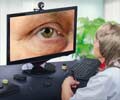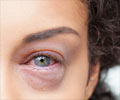In what is believed to be the first comprehensive eye disease study among urban pre-schoolers, Johns Hopkins investigators report that while vision problems are rare, they are more
Johns Hopkins investigators have reported that eye disease among urban pre-schoolers, though still rare, are more common than previously believed. Also, in some botched up cases, it has been seen that some children receive eye treatments that they don't need while another small group of preschoolers with simple and easily treatable vision problems went untreated.
Writing in the April issue of the journal Ophthalmology, investigators from the Johns Hopkins Children's Center and the Johns Hopkins Bloomberg School of Public Health say 5 percent of the nearly 2,300 Baltimore area children who were followed in the study, had refractive errors—a defect in the eye's ability to focus light—significant enough to require treatment, but only 1 percent actually were treated. Among 29 children who had a prescription for eyeglasses before entering the study, more than one-third didn't need eyeglasses.Undetected and untreated, refractive errors can cause loss of visual acuity and eventually lead to amblyopia (lazy eye) and strabismus (crossed eyes), which are hard or impossible to reverse after age 7.
In the study, more than half of the 1,268 black children (55 percent) had some refractive errors as did half (51 percent) of the 1,030 white children. Because overall, one in 20 children studied had a problem that is easily treated, the researchers suggest that pediatricians screen routinely during physicals and parents should insist on screening by age 4.
"The good news is that serious eye disease in preschoolers appears to be uncommon, but the bad news is that we're missing kids who need treatment and treating some children who don't need it," says investigator Michael X. Repka, M.D., deputy director of ophthalmology at Hopkins Children's.
A surprising additional finding in the report is that contrary to previous research suggesting that most infants will outgrow their farsightedness in the first few years of life, few children in the Baltimore study did outgrow it during their preschool years, making early diagnosis and treatment critical, says lead investigator David Friedman, M.D., Ph.D., of the Johns Hopkins School of Medicine and the Bloomberg School of Public Health.
Hyperopia, or farsightedness, was the most common abnormality, occurring more often in white children (40 percent of 1,030) than in black children (31 percent of 1,268).
Advertisement
Other findings:
- Only 3 percent of all children in the study had severe farsightedness, while only 0.6 percent had severe near-sightedness.
- Only 1 percent of black children and 1.5 percent of white children had a difference in vision between the two eyes (anisometropia) that required treatment.
- Fewer than 3 percent of children had serious astigmatism, an optical defect that can cause lazy eye, blurred vision, headaches, eye strain and fatigue.
Advertisement
TAN/L












